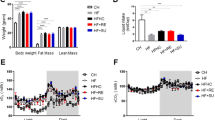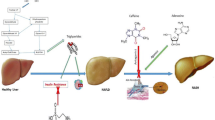Abstract
Purpose of Review
The purpose of this paper is to both review the available data and also highlight the gaps in knowledge, regarding the link between pediatric NASH and different types of sweeteners including caloric sweeteners (CS) and non-caloric sweeteners (NCS).
Recent Findings
Studies have demonstrated that patients with NASH generally have had an unhealthy diet, characterized by on overconsumption of carbohydrates especially fructose. Mechanistically, a high-fructose diet reduces hepatic lipid oxidation, increases proinflammatory response, increases intestinal permeability, and decreases microbiome diversity. Consumption and availability of NCS has therefore been increasing dramatically. Most NCS are not considered to be metabolized in the body and therefore thought to be safe for consumption. It was reported that pharmacological properties of rebaudioside, a type of NCS, as a potential hepatoprotector are through anti-inflammatory and antifibrotic mechanisms, associated with enhancing glucose-induced insulin secretion and inducing the difference of microbiome diversity.
Summary
Diet is an important factor in the pathogenesis of NAFLD and popular dietary patterns are contributing to the increased replacement of natural sweeteners with NCS. Screening for NAFLD by pediatricians and counseling on the avoidance of sugar-sweetened beverages are recommended. We feel that the various NCS available to the consumer today merit further investigation and may potentially have hitherto unknown effects on hepatic metabolic function.

Similar content being viewed by others
Abbreviations
- NAFLD:
-
Nonalcoholic fatty liver disease
- NASH:
-
Nonalcoholic steatohepatitis
- CS:
-
Caloric sweeteners
- NCS:
-
Non-caloric sweeteners
- DNL:
-
De novo lipogenesis
References and Recommended Reading
Papers of particular interest, published recently, have been highlighted as: • Of importance •• Of major importance
Barr, S.B. and J.C. Wright, Postprandial energy expenditure in whole-food and processed-food meals: implications for daily energy expenditure. Food Nutr Res, 2010. 54.
Boursier J, et al. The severity of nonalcoholic fatty liver disease is associated with gut dysbiosis and shift in the metabolic function of the gut microbiota. Hepatology. 2016;63(3):764–75.
• Vos MB, et al. NASPGHAN clinical practice guideline for the diagnosis and treatment of nonalcoholic fatty liver disease in children: recommendations from the Expert Committee on NAFLD (ECON) and the North American Society of Pediatric Gastroenterology, Hepatology and Nutrition (NASPGHAN). J Pediatr Gastroenterol Nutr. 2017;64(2):319–34 This guideline highlights that the expert NASPGHAN committee on NAFLD reviewed and summarized the available literature, formulating recommendations to guide screening and clinical care of children with NAFLD.
Brown GT, Kleiner DE. Histopathology of nonalcoholic fatty liver disease and nonalcoholic steatohepatitis. Metabolism. 2016;65(8):1080–6.
Anstee QM, et al. From NASH to HCC: current concepts and future challenges. Nat Rev Gastroenterol Hepatol. 2019;16(7):411–28.
Sharp KH, Schultz M, Coppell KJ. Is non-alcoholic fatty liver disease a reflection of what we eat or simply how much we eat? JGH Open. 2018;2(2):59–74.
Carr RM. In NAFLD, You are what you eat, not simply how much you eat. Cell Mol Gastroenterol Hepatol. 2017;4(2):301–2.
Nowlis GH, Kessen W. Human newborns differentiate differing concentrations of sucrose and glucose. Science. 1976;191(4229):865–6.
•• Schwimmer JB, et al. Effect of a low free sugar diet vs usual diet on nonalcoholic fatty liver disease in adolescent boys: a randomized clinical trial. JAMA. 2019;321(3):256–65 This study highlights that in adolescent boys with NAFLD, 8 weeks of provision of a diet low in free-sugar content compared with usual diet resulted in significant improvement in hepatic steatosis.
Duwaerts CC, Maher JJ. Macronutrients and the adipose-liver axis in obesity and fatty liver. Cell Mol Gastroenterol Hepatol. 2019;7(4):749–61.
Softic S, Cohen DE, Kahn CR. Role of dietary fructose and hepatic de novo lipogenesis in fatty liver disease. Dig Dis Sci. 2016;61(5):1282–93.
Eslamparast T, Tandon, Raman M. Dietary composition independent of weight loss in the management of non-alcoholic fatty liver disease. Nutrients. 2017;9(8):E800.
Pereira RM, et al. Fructose consumption in the development of obesity and the effects of different protocols of physical exercise on the hepatic metabolism. Nutrients. 2017;9(4):E405.
Jensen T, et al. Fructose and sugar: a major mediator of non-alcoholic fatty liver disease. J Hepatol. 2018;68(5):1063–75.
Abdelmalek MF, et al. Increased fructose consumption is associated with fibrosis severity in patients with nonalcoholic fatty liver disease. Hepatology. 2010;51(6):1961–71.
Mosca A, et al. Beverage consumption and paediatric NAFLD. Eat Weight Disord. 2016;21(4):581–8.
Jones RB, et al., High intake of dietary fructose in overweight/obese teenagers associated with depletion of Eubacterium and Streptococcus in gut microbiome. Gut Microbes, 2019: 1–8.
Canfora EE, et al. Gut microbial metabolites in obesity, NAFLD and T2DM. Nat Rev Endocrinol. 2019;15(5):261–73.
Swithers SE. Artificial sweeteners produce the counterintuitive effect of inducing metabolic derangements. Trends Endocrinol Metab. 2013;24(9):431–41.
Roberts A. The safety and regulatory process for low calorie sweeteners in the United States. Physiol Behav. 2016;164(Pt B):439–44.
Durán Agüero S, et al. Noncaloric sweeteners in children: a controversial theme. Biomed Res Int. 2018;2018:4806534.
Mattes RD, Popkin BM. Nonnutritive sweetener consumption in humans: effects on appetite and food intake and their putative mechanisms. Am J Clin Nutr. 2009;89(1):1–14.
Pepino MY. Metabolic effects of non-nutritive sweeteners. Physiol Behav. 2015;152(Pt B):450–5.
• Suez J, et al. Artificial sweeteners induce glucose intolerance by altering the gut microbiota. Nature. 2014;514(7521):181–6 This article demonstrates that consumption of commonly used non-caloric sweeteners drives the development of glucose intolerance through induction of compositional and functional alterations to the intestinal microbiota, linked to host susceptibility to metabolic disease.
Samuel, et al. Stevia leaf to stevia sweetener: exploring its science, benefits, and future potential. J Nutr. 2018;148(7):1186S–205S.
Momtazi-Borojeni AA, et al. A review on the pharmacology and toxicology of steviol glycosides extracted from Stevia rebaudiana. Curr Pharm Des. 2017;23(11):1616–22.
Reynolds TH, et al. Long term rebaudioside A treatment does not alter circadian activity rhythms, adiposity, or insulin action in male mice. PLoS One. 2017;12(5):e0177138.
Do MH, et al. High-glucose or -fructose diet cause changes of the gut microbiota and metabolic disorders in mice without body weight change. Nutrients. 2018;10(6):186–202.
•• de Ruyter JC, et al. A trial of sugar-free or sugar-sweetened beverages and body weight in children. N Engl J Med. 2012;367(15):1397–406 This study reported that masked replacement of sugar-containing beverages with non-caloric beverages reduced weight gain and fat accumulation in normal-weight children.
Molinaro A, et al. Host-microbiota interaction induces bi-phasic inflammation and glucose intolerance in mice. Mol Metab. 2017;6(11):1371–80.
Casas-Grajales S, et al. Rebaudioside A administration prevents experimental liver fibrosis: an in vivo and in vitro study of the mechanisms of action involved. J Appl Toxicol. 2019.
Wang Y, et al. New application of the commercial sweetener rebaudioside a as a hepatoprotective candidate: induction of the Nrf2 signaling pathway. Eur J Pharmacol. 2018;822:128–37.
Philippaert K, et al. Steviol glycosides enhance pancreatic beta-cell function and taste sensation by potentiation of TRPM5 channel activity. Nat Commun. 2017;8:14733.
Wang Q, et al. Non-nutritive sweeteners possess a bacteriostatic effect and alter gut microbiota in mice. PLoS One. 2018;13(7):e0199080.
Mandić AD, Blaut M. Do we choose control diets wisely? Trends Endocrinol Metab. 2018;29(7):447–8.
Schwenger KJ, et al. Non-alcoholic fatty liver disease and obesity: the role of the gut bacteria. Eur J Nutr. 2018.
Chi L, et al. Effects of the artificial sweetener neotame on the gut microbiome and fecal metabolites in mice. Molecules. 2018;23(2):E367.
Nettleton JE, et al. Low-dose stevia (Rebaudioside A) consumption perturbs gut microbiota and the mesolimbic dopamine reward system. Nutrients. 2019;11(6):E1248.
Author information
Authors and Affiliations
Corresponding author
Ethics declarations
Conflict of interest
Dong Xi declares that he no conflict of interest. Rohit Kohli declares that he no conflict of interest.
Human and Animal Rights and Informed Consent
This article does not contain any studies with human or animal subjects performed by any of the authors.
Additional information
Publisher’s Note
Springer Nature remains neutral with regard to jurisdictional claims in published maps and institutional affiliations.
This article is part of the Topical Collection on Pediatric Gastroenterology
Rights and permissions
About this article
Cite this article
Xi, D., Kohli, R. When the Beverage Is Sweet, How Does the Liver Feel?. Curr Treat Options Peds 5, 458–465 (2019). https://doi.org/10.1007/s40746-019-00177-0
Published:
Issue Date:
DOI: https://doi.org/10.1007/s40746-019-00177-0




